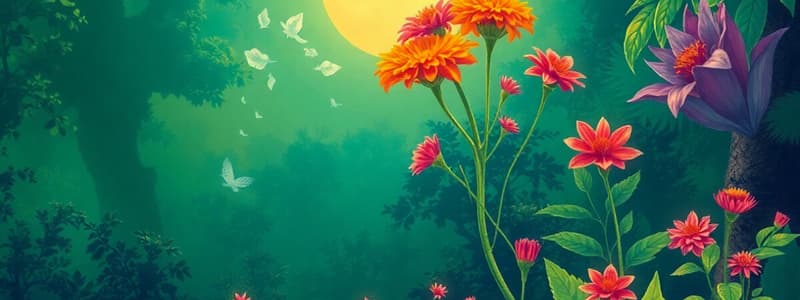Podcast
Questions and Answers
What does the term 'biodiversity' refer to?
What does the term 'biodiversity' refer to?
- Variability among living organisms from various sources (correct)
- The variety of ecosystems in a specific area
- The differences in physical characteristics among species
- The classification of living organisms into distinct groups
Which country ranks 10th among the plant-rich countries of the world?
Which country ranks 10th among the plant-rich countries of the world?
- India (correct)
- United States
- Brazil
- China
What is genetic diversity primarily responsible for?
What is genetic diversity primarily responsible for?
- Variations among the genes of the same species (correct)
- Differences in species across biogeographical areas
- The creation of entirely new species
- Variation among different ecosystems
Which of the following best describes species diversity?
Which of the following best describes species diversity?
Which of the following is an example of ecosystem diversity?
Which of the following is an example of ecosystem diversity?
What type of value is derived from silk harvested from silkworms and wool from sheep?
What type of value is derived from silk harvested from silkworms and wool from sheep?
What increments the significance of biodiversity in agriculture?
What increments the significance of biodiversity in agriculture?
Which term describes the unique species found exclusively in a specific region?
Which term describes the unique species found exclusively in a specific region?
Which of the following regions is recognized as a biodiversity hotspot in India?
Which of the following regions is recognized as a biodiversity hotspot in India?
What defines an endangered species?
What defines an endangered species?
Which of the following is an example of a vulnerable species in India?
Which of the following is an example of a vulnerable species in India?
What does the term 'rare species' refer to?
What does the term 'rare species' refer to?
What is the purpose of the Red Data Book?
What is the purpose of the Red Data Book?
Which species is known as 'kala hiran' in India?
Which species is known as 'kala hiran' in India?
Why are certain species classified as vulnerable?
Why are certain species classified as vulnerable?
What is the main characteristic of rare species as per the International Union for Conservation of Nature?
What is the main characteristic of rare species as per the International Union for Conservation of Nature?
Which of the following is NOT classified as a phytogeographical region of India?
Which of the following is NOT classified as a phytogeographical region of India?
What type of diversity is included in the fields of diversity identified for India as a mega-diversity nation?
What type of diversity is included in the fields of diversity identified for India as a mega-diversity nation?
Which zoogeographical region is found in the southern part of India?
Which zoogeographical region is found in the southern part of India?
How many mega-diverse countries did Conservation International identify in 1998?
How many mega-diverse countries did Conservation International identify in 1998?
Which of the following regions is part of both phytogeographical and zoogeographical classifications in India?
Which of the following regions is part of both phytogeographical and zoogeographical classifications in India?
Which of the following species is not considered an EDGE species?
Which of the following species is not considered an EDGE species?
What is the primary threat to the existence of the black buck?
What is the primary threat to the existence of the black buck?
Which of the following is an example of an endemic plant in India?
Which of the following is an example of an endemic plant in India?
What does endemism refer to in biological terms?
What does endemism refer to in biological terms?
Which animal is not listed as endemic to India?
Which animal is not listed as endemic to India?
What is a characteristic of EDGE species?
What is a characteristic of EDGE species?
Why should open plains be conserved for the black buck?
Why should open plains be conserved for the black buck?
Which of the following is considered a threat to biodiversity?
Which of the following is considered a threat to biodiversity?
What is the primary purpose of botanical gardens?
What is the primary purpose of botanical gardens?
What type of bank is a pollen bank categorized as?
What type of bank is a pollen bank categorized as?
What is a potential disadvantage of ex-situ conservation?
What is a potential disadvantage of ex-situ conservation?
Which technique is used for asexual propagation in plants?
Which technique is used for asexual propagation in plants?
Which of the following statements about DNA technology is true?
Which of the following statements about DNA technology is true?
What issue commonly arises during man-wildlife conflict?
What issue commonly arises during man-wildlife conflict?
What is a benefit of ex-situ conservation?
What is a benefit of ex-situ conservation?
How does ex-situ conservation primarily affect breeding?
How does ex-situ conservation primarily affect breeding?
Study Notes
What is Biodiversity
- Biodiversity combines "bio" (life) and "diversity," representing the variety of living organisms across ecosystems.
- The Convention on Biological Diversity was established in 1992 during the Rio Earth Summit.
- India ranks 10th globally in plant richness, 11th in endemic higher vertebrates, and 6th in agricultural crop diversity.
Levels of Biodiversity
- Genetic Diversity: Variations within the genes of the same species, leading to different varieties (e.g., rice, mangoes).
- Species Diversity: Variation among species within a specific area (e.g., horses distinct from donkeys).
- Ecosystem Diversity: Variety of habitats and life forms within them, encompassing different ecosystems within geographical boundaries.
Values of Biodiversity
- Productive Value: Various products are sourced from organisms, including silk from silkworms and wool from sheep.
Hot Spots of Biodiversity
- Major biodiversity hotspots in India include:
- Western Ghats
- Eastern Himalayas
- Indo-Burma region
- Sundaland (Nicobar Islands)
Endangered Species
- Species close to extinction are classified as endangered (e.g., red panda, Gir lion, Gharial, Great Indian bustard).
Vulnerable Species
- Vulnerable species are likely to become endangered without improved circumstances (e.g., Sarus crane, Nilgiri Langur, Barasingha).
Rare Species
- Rare species are uncommon or infrequently encountered and not classified as endangered but are "at risk."
Red Data Book
- A document by IUCN that catalogs rare and endangered species of flora and fauna, including local species.
Endangered Black Buck
- Also known as kala hiran, previously widespread in India but now limited to parts of Punjab, Gujarat, and Rajasthan due to poaching and habitat loss.
Endemic Species
- Species native to a particular region, with limited distribution (e.g., True Cardamom, One-horned rhino, Royal Bengal tiger).
EDGE Species
- Evolutionarily Distinct and Globally Endangered species have unique evolutionary histories and few close relatives (e.g., Asian elephants, red pandas).
Ex-situ Conservation
- Botanical Gardens: Preserve rare and endangered plant species and promote research and sustainable development.
- Tissue Culture Technique: Asexual propagation method using plant cells in sterile conditions to conserve genetic material.
- DNA Technology: Uses DNA conservation methods for biodiversity preservation.
Advantages and Disadvantages of Ex-situ Conservation
- Advantages:
- Complete protection from predation and poaching.
- Extended survival rates and possible hybrid breeding.
- Improved offspring quality through genetic techniques.
- Disadvantages:
- Abnormal behavior in animals can complicate reproduction.
Man-Wildlife Conflict
- Conflicts arise when wildlife threatens human safety and damages property, complicating conservation efforts.
Phyto-geographical Regions of India
- India categorized into regions based on flora:
- Western Himalayas
- Eastern Himalayas
- Western Deserts
- Gangetic Plains
- Central India
- Western Coast
- Deccan Plateau
- North-East India
- Andaman and Nicobar Islands
Zoo-geographical Regions of India
- India divided into regions based on fauna:
- Himalayan Region
- Malabar Region
- Nilgiri Region
- Northern Plains
- Desert Lands
- Deccan Plateau Region
India: A Mega-diversity Nation
- Recognized as one of 18 mega-diverse countries by Conservation International in 1998.
- Key fields of diversity in India include geographical, climatic, habitat, cultural, and biodiversity.
Studying That Suits You
Use AI to generate personalized quizzes and flashcards to suit your learning preferences.
Related Documents
Description
This quiz explores the various phyto-geographical regions of India, highlighting their unique flora. Participants will learn about regions such as the Western and Eastern Himalayas, Western Deserts, Gangetic Plains, and more. Understanding these regions is essential for biodiversity study and environmental science.




